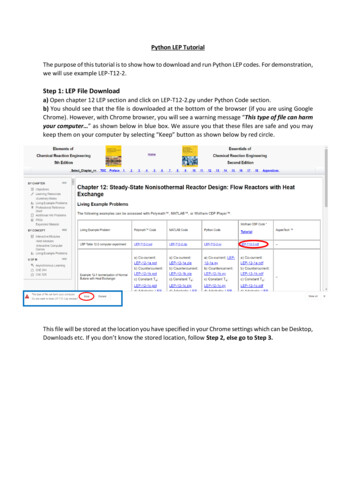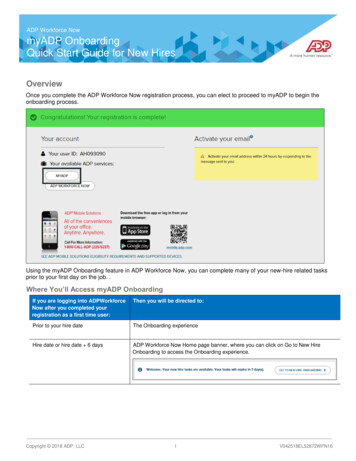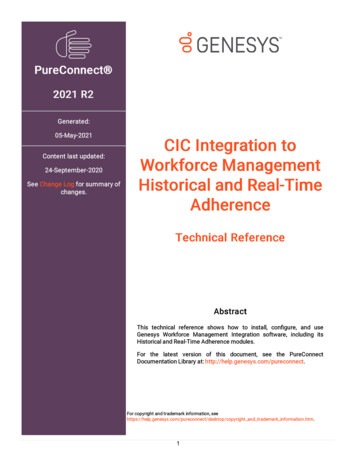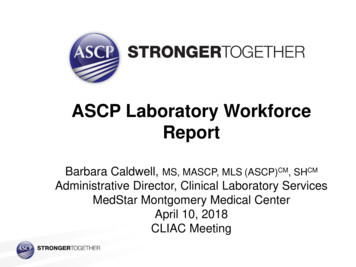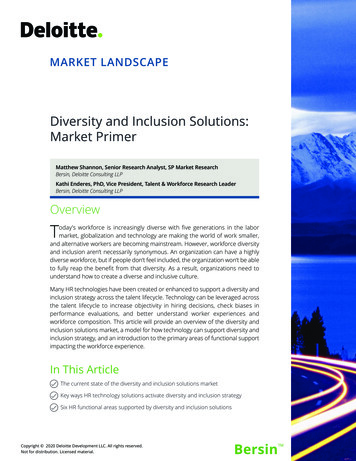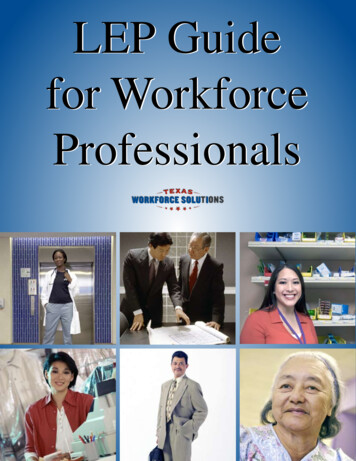
Transcription
LEP Guidefor WorkforceProfessionals
IntroductionLEP Guide for Workforce ProfessionalsContentsIntroductionWhat Is the LEP Guide?Anson GreenModule 1Effective Intake and Case ManagementVirginia PriceModule 2Nontraditional Occupations and Entrepreneurial OpportunitiesVirginia PriceModule 3Scorecards for Evaluating Training Services for LEP CustomersDr. Federico Zaragoza, Anson Green, Virginia PriceModule 4Comprehensive Assessment for LEP CustomersDr. Federico Zaragoza, Anson Green, Virginia Price
IntroductionLEP Guide for Workforce ProfessionalsLEP Guide for Workforce ProfessionalsEdited by Anson GreenCopies of this guide are available 07Texas Workforce Commission101 E 15th St.Austin, TX 78778-0001http://www.texasworkforce.orgEqual Opportunity Employer/ProgramsAuxiliary aids and services are available, on request, to individuals with disabilities.The opinions contained in this publication are those of the grantee, Genesis21, anddo not necessarily reflect those of the Texas Workforce Commission.
IntroductionIntroduction: What Is the LEP Guide?LEP Guide for Workforce ProfessionalsAnson GreenWorkers and job seekers with limited English proficiency (LEP) are one of the fastest-growing segmentsof the Texas workforce. The LEP Guide for Workforce Professionals (LEP Guide) was created to assistworkforce professionals in planning, developing, and implementing strategies that effectively deliverworkforce solutions for this valuable population. Local Workforce Development Boards (Boards) andstaff, Texas Workforce Center staff, and education and training professionals can use the LEP Guide’sfour unique modules as a user-friendly blueprint for enhancing services to LEP customers.Why an LEP Guide?The Current and Future Workforce In 2005, Texas joined Hawaii, New Mexico, and California as majority-minority states. The fastestgrowing key segment of the population is Hispanics (U.S. Census Bureau, 2005). Between 2000 and 2005, the number of foreign-born LEP individuals age five and older increasedover 29 percent to 2,197,648 (Migration Policy Institute, n.d.). Between 2010 and 2030, first- and second-generation immigrants together are projected toaccount for all U.S. labor force growth (Lowell, B., Gelatt, J., Batalova, J., 2006). Although 30 percent of immigrant workers have less than a high school education and tend to beemployed in low-wage occupations, almost one-third of the foreign-born LEP population haveattained the equivalency of a bachelor’s degree or higher in their native country (Capps, Fix,Passel, Ost, Perez-Lopez, 2003).The LEP Pipeline in Public Schools In 2005–2006, almost half of the Texas public school population were Hispanic. Over 34 percentof these students were LEP (Texas Education Agency, n.d.). Hispanic students account for over 50 percent of high school students lost to attrition. In 2005–2006, Hispanic attrition rates increased by 4 percent (Johnson, 2006). In 2006, only 12 percent of LEP students in the twelfth grade passed the Texas Assessment ofKnowledge and Skills (TAKS) test and only 8 percent of tenth graders passed all TAKS standards(Scharrer, 2007). Texas has slipped from 45th to last among states ranked by percent for citizens in 2005—age 25and older—who have a high school diploma or General Equivalency Development credential(Murdock, 2007).Current Readiness to Meet Business and LEP Customer Employment Needs In Texas, 57 percent of the 28 local workforce development areas (workforce areas) do not havelocal training providers that offer LEP-accessible occupational training programs (e.g., Spanishlanguage or bilingual training programs). Less than 6 percent of Texas employers have worked with adult education providers for Englishlanguage or workplace literacy services (Texas Workforce Investment Council, 2006). Since 2001, there has been a 75 percent decrease in adult education students, including LEPstudents, who have the goal of transitioning to postsecondary training (Legislative Budget Board,2007).i
IntroductionLEP Guide for Workforce ProfessionalsHow the LEP Guide Can HelpThe LEP Guide can assist workforce, education, and training professionals plan, develop, andimplement strategies to effectively deliver workforce solutions for the growing LEP workforcein Texas.The LEP Guide comprises four unique modules that present a user-friendly blueprint forenhancing services to LEP customers.Module 1: Effective Intake and Case ManagementThis module guides effective, culturally responsive intake and case management services forLEP customers by introducing key concepts, promising practices, and strategies that can beused to maximize efforts and enhance the quality of services provided.Module 2: Nontraditional Occupations and Entrepreneurial OpportunitiesThis module develops and implements effective strategies to support female LEP customers asthey consider occupations that are not traditionally held or sought by women, or embark upona path leading to small business ownership.Module 3: Scorecards for Evaluating Training Services for LEP CustomersThis module uses a balanced scorecard approach to assist workforce professionals inevaluating the effectiveness of education training courses for LEP customers. Five differentscorecards measure unique areas that are critical to delivering LEP training programs basedon local business demand and provide “driving directions” for engaging employers in trainingefforts. The five scorecards can assist Workforce Boards in: selecting courses for inclusion on the Eligible Training Provider List or other WorkforceBoard–approved vendor lists; improving the planning and evaluation of programs designed to connect LEP customers tohigh-growth, high-demand occupations; developing Requests for Proposals; and guiding training and adult education capacity-building efforts.ii
IntroductionLEP Guide for Workforce Professionals\Module 4: Comprehensive Assessment for LEP CustomersThis module guides the selection and use of appropriate assessment tests for LEP customersto ensure that their skills and abilities are assessed appropriately in order to make sound,evidence-based referrals to businesses or training providers.Although the LEP Guide is specifically designed for Workforce Board and Workforce Centerstaff, it also provides beneficial information to community and technical colleges, adulteducation providers, community-based organizations, career schools, and other organizationsthat work with LEP customers seeking employment.The LEP Guide’s four modules provide a truly integrated approach to improving employment,literacy, and training services. The LEP Guide stresses the strong interrelationship betweencase management, assessment, instruction, and job development in culturally relevantcontexts.LEP DefinedLEP is used to describe individuals who speak English as a second language andwho have rated their ability to speak English as “well,” “not well,” or “not atall” (RTI International, 2005). While some individuals often have less than theequivalent of an elementary school education, many have postsecondary degreesfrom their home country. Thus LEP should be viewed as an identification of lowlevels of English comprehension, not limited education or low basic skills.Characteristics of persons who are LEP: Do not speak English as their primary language. Have a limited ability to read, speak, write, or understand English. Native language is not English. Live in a family or community environment in which a language other thanEnglish is dominant.Source: Texas Workforce Commission, 2006iii
IntroductionLEP Guide for Workforce ProfessionalsA Market-Driven Work-BasedESL Training System for TexasAnson GreenWe “cannot afford to leave any workers behind and the Texas workforce systemmust direct resources and training investments to ensure that no worker is leftbehind.”Texas Workforce Commission, 2005Supporting Business CompetitivenessRemaining competitive in regional, national, and globalmarketplaces is a top priority for Texas businesses.Texas’ attractive business and economic climate restslargely on the availability of a workforce that is young,growing, and well educated. The Texas workforce hasradically changed in the last decade and will seecontinued changes, especially demographic changes, intothe future.From 1980 to 2000, 26.7 millionnew native-born workers age 2554 provided the workforceneeded for our dynamicallygrowing economy. From nowuntil 2021, there will be no additional native-born workers in thisprime age group. None.Source: Ellwood, 2002, p. 11In the last 10 years, Texas’ population has grown,become more diverse, and less educated. However, a good sign for Texas’ future workforceis that its population is also becoming younger, unlike some states with shrinking populationsand, therefore, an older population average. New Hispanic, Spanish-speaking residents havefueled this population growth, challenging education and training systems—from preschool tohigher education—to redesign and rethink legacy educational paradigms in order to meet theneeds of this current and future workforce.Losing Ground in Educating LEP Youth and AdultsTexas is losing ground in educating and training the state’s LEP youth population: Passing TAKS scores are lowest and dropout rates are highest for Texas’ Hispanic youth. The percentage of Hispanic youth graduating from high school is the lowest in Texas, atjust under 58 percent (Editorial Projects in Education Research Center, 2006). Overall, Texas has slipped from 45th to last among states ranked by percent withpopulations age 25 and older in 2005 with a high school diploma (Murdock, 2007).iv
IntroductionLEP Guide for Workforce ProfessionalsAdditionally, Texas’ LEP adult population’s education and training systems need significantenhancements. To be competitive in the job market, LEP workers benefit from having higherlevels of English literacy, yet few LEP workers with employment or employment advancementgoals appear to access Texas’ adult education system for English as a Second Language (ESL)services. According to the Texas Education Agency, only 1,445 of over 108,000 adulteducation students, including ESL students, had the goal of entering employment in 2005–2006. Of those, just 655 students reported finding jobs (National Reporting System, n.d.).The numbers of all adult education students continuing their education through thepostsecondary education level or into training are equally low. While some postsecondaryeducation or training is required for almost all jobs today (National Center on Education andthe Economy, 2007), in 2005–2006, just 602 of over 108,000 adult education students inTexas reported a goal of transitioning into college or occupational training. Of those, just 172students statewide reported accomplishing this goal (National Reporting System, n.d.).In 2007, the Legislative Budget Board identified that rather than increasing the transition topostsecondary training for students, there has been a 75 percent decrease in adult educationstudents with a goal of transitioning to postsecondary training over the last few years.Fortunately, the State is working to stem this trend through legislation passed by the 80thTexas Legislature.1While data may not tell the whole story, and surely more adult education students haveemployment and higher education goals, it appears that significant work must be done toensure these students see adult education programs as a means to transitioning intooccupational training or other postsecondary education and career-building jobs.The transition to postsecondary training is particularly challenging for LEP customers.Research shows that even if LEP customers have training goals, 57 percent of the workforceareas in Texas do not have local training providers that offer LEP-accessible training programs(e.g., Spanish-language or bilingual occupational training programs). Many training providersstill establish minimum reading standards (e.g., sixth- or ninth-grade reading level) forenrollment in occupational training. Often, these literacy requirements are higher than thoseactually required for performing on the job (Spruck-Wrigley, Richer, Martinson, Kubo, andStrawn et al., 2003).Developing Workforce Solutions Using the LEP GuideCurrent education and training trends are of little benefit to employers trying to fill criticallabor shortages with skilled workers. Texas employers must continue to compete in theglobal marketplace and maintaining a skilled workforce is one of their prime concerns.Supporting the employment and training goals of the LEP workforce is clearly a core missionfor Workforce Boards, training providers, and adult education programs.Between 2010 and 2030, first- and second-generation immigrants together are projected toaccount for all U.S. labor force growth (Migration Policy Institute, 2006). Workforce Boards,training providers, adult education programs, and other community partners must formworking partnerships that have a shared goal of increasing the employment success of theLEP workforce. Workforce Boards are well positioned to lead these efforts and the LEP Guidecan assist them in developing workforce solutions for Texas businesses and LEP customers.1House Bill 1, 80th Texas Legislature, Regular Session, includes a rider that addresses the alignment of adult education and postsecondary education services. The rider is listed as Texas Higher Education Coordinating Board Rider 50 and Texas Education Agency Rider 77.v
IntroductionLEP Guide for Workforce ProfessionalsReferencesEditorial Projects in Education Research Center. (2006). Diplomas count: An essential guide tograduation policy and rates. Bethesda, MD: Author.Ellwood, D. (2002). How we got here. In The Aspen Institute, Grow faster together. Or growslowly apart. How will America work in the 21st Century? Washington, DC: The AspenInstitute.Johnson, R. (2006). Texas public school attrition study 2005–2006. Gap continues to grow. SanAntonio, TX: Intercultural Development Research Association.Legislative Budget Board (2007). Texas state government effectiveness and efficiency. Austin,TX: Author.Lowell, B., Gelatt, J., Batalova, J. (2006). Immigrants and labor force trends: The future, past,and present. MPI Insight NO. 17. Washington, DC: Migration Policy Institute.Migration Policy Institute (n.d.). Fact sheet on the foreign born: Language and educationcharacteristics. Washington, DC: Migration Policy Institute.Lowell, B., Gelatt, J., Batalova, J. (2006). Immigrants and labor force trends: The future, past,and present. MPI Insight NO. 17. Washington, DC: Migration Policy Institute.Murdock, S. (2007, June). Population change in Texas: Implications for human and socioeconomicresources in the 21st century. Presentation delivered at the Texas Higher EducationCoordinating Board P-16 Conference. Retrieved August 29, 2007, from http://txsdc.utsa.edu/presentations/National Center on Education and the Economy (2007). Tough choice or tough times, the reportof the new commission on the skills of the American workforce. San Francisco, CA:Jossey-BassNational Reporting System (n.d.). [Statistical and financial data on state adult educationperformance]. Retrieved June 4, 2007, les/view.cfmstate TX&year 2005&tableID 1Scharrer, G. (2007, April 29). Bill, group want more monitoring of bilingual education. San AntonioExpress News, p.5B.Texas Education Agency (n.d.). Texas public school districts, including charter schools’ LEPstudents by category and language. County district report school year 2005–2006. PublicEducation Information Management System Data. Retrieved September 1, 2007, fromhttp://www.tea.state.tx.us/adhocrpt/Core Products/IN10610.pdfTexas Workforce Commission. (2005). Strategic two-year state workforce investment plan for titleI of the Workforce Investment Act of 1998 and the Wagner-Peyser Act, part 1 for theperiod of July 1, 2005 – June 30, 2007. Austin, TX: Author. Retrieved September 1, 2007,from http://www.twc.state.tx.us/boards/wia/state plan/07stateplan.pdfTexas Workforce Commission. (2006). Integration of Trade services for dislocated workers: Acomprehensive guide. Austin, TX: Author. Retrieved September 1, 2007, from e.pdfTexas Workforce Investment Council. (2006). The Texas workforce development system, 2006employer survey. Austin, TX: Author.U.S. Census Bureau. (2005). Texas becomes nation’s newest majority-minority state, CensusBureau announces [press release]. Retrieved September 1, 2007, from rchives/population/005514.htmlWrigley, H. S., Richer, E., Martineson, K., Kubo, H., & Strawn, J. (2003). The language ofopportunity: Expanding employment prospects for adults with limited English skills.Washington, DC: Center for Law and Social Policy.vi
Effective Intake & Case ManagementLEP Guide for Workforce ProfessionalsLEP GUIDE FORWORKFORCEPROFESSIONALSModule 1: Effective Intake & CaseManagementTexas Workforce SolutionsModule 1, Page
Effective Intake & Case ManagementLEP Guide for Workforce ProfessionalsLEP Guide for Workforce ProfessionalsEdited by Anson GreenCopies of this guide are available 07Texas Workforce Commission101 E 15th StAustin, TX 78778-0001http://www.texasworkforce.orgEqual Opportunity Employer/ProgramsAuxiliary aids and services are available, on request, to individuals with disabilities.The opinions contained in this publication are those of the grantee, Genesis21, anddo not necessarily reflect those of the Texas Workforce Commission.Texas Workforce SolutionsModule 1, Page 2
Effective Intake & Case ManagementLEP Guide for Workforce ProfessionalsAcknowledgementsThe author of this module is Virginia Price.Genesis21, Project Coordinator, wishes to thank themany partners that made this guide possible:The Texas Workforce Commission, especially AnsonGreen, whose labor, encouragement, and unwaveringdedication helped bring it to completion.The Local Workforce Development Boards across thestate that shared their experiences, plans, andsuggestions.The Texas Workforce Centers, contractors, and serviceproviders who allowed us come in and speak withstaff, case managers, and management teams andthose who sat and discussed the challenges andsolutions that are already helping customers.The members of our advisory committee who spentcountless hours meeting and discussing their ownfrustrations and determination to work toward mean ingful solutions: Ralph Briones, Kim Bunting, FranciscoCastellanos, Rebecca Cervantes, Sharon Davis, BonnieGonzalez, Karl Haigler, David Lindsay, Dr. Ana HuertaMacias, Kay O’Dell, Joanie Rethlake, Linda Rivas,Lorenzo Reyes, and Nicki Valdez.This guide was made possible by the quietdetermination of a small group of people who believein the system. We hope that it meets the needs ofthose whom they have struggled to help and leads tostronger relationships and enhanced service foreveryone.Texas Workforce SolutionsLEP Guide for WorkforceProfessionalsThe LEP Guide for Workforce Professionalsconsists of four individual modules, each a keycomponent of the Texas workforce system.Each module is meant to assist Local WorkforceDevelopment Boards (Workforce Boards),Texas Workforce Center (Workforce Center)staff, and system partners on how best to servethe limited English proficiency (LEP) populationfrom entrance to post employment. The fourmodules are:Module 1Effective Intake & CounselingPart 1. What Workforce Boards Can Doto Plan and Develop EffectiveLimited English Proficiency SkillsPart 2. Enhancing Workforce ServicesModule 2Nontraditional Occupations andEntrepreneurial OpportunitiesModule 3Scorecards for Evaluating TrainingServices for LEP CustomersModule 4Comprehensive Assessment for Customerswith Limited English ProficiencyModule 1, Page 3
Effective Intake & Case ManagementLEP Guide for Workforce ProfessionalsContentsTerms Used in This Module . 7Introduction: Enhancing the Effectiveness of WorkforceServices for Customers with Limited English Proficiency .10Part 1. What Workforce Boards Can Do to Plan and DevelopEffective LEP Services 12Section 1. Assessing and Developing Greater Capacityto Serve LEP Customers . 13Analysis and Guidelines . 13Translators and Interpreters . . 14Section 2. Setting Standards at the Very Beginning: Waysto Incorporate LEP Standards into Procurements .14Section 3. Developing a Dream Team of Experts: Usingand Developing Skills and Talents to Deliver Effective Services. 15Identifying, Tracking, and Monitoring Services:Learning More about the Types of Services LEP CustomersNeed .16Section 4. Encouraging Rapid Response Teams to SpreadTheir Wings: Enhanced Services and Offerings . 17Section 5. Sharing Information on Economic Trends andHigh-Growth, High-Demand Occupations with WorkforceCenter Staff . 18Review Part 1: What Workforce Boards Can Do to Planand Develop Effective LEP Services 19Part 2. Enhancing Workforce Center Services: The Right Tools ofthe Trade for Frontline Staff . 20Section 1. The Importance of Case Managers: BuildingModels That Support LEP Customers . 20Keeping Things Positive, A Basis for Success:Developing a Strengths-Based Case Management Model.21Discovering Things That Count: Person-CenteredStrengths Assessment . 21Additional Strategies to Support a Strengths-BasedApproach . 23Recognize the Customer’s Interpretation of TheirCircumstances . 23Texas Workforce SolutionsModule 1, Page 4
Effective Intake & Case ManagementLEP Guide for Workforce ProfessionalsFind Ways to Establish Common Ground . 24Spend More One-on-One Time . 24Taking What You Have and Using It Correctly:Making the Most of the Initial Intake 24Meeting in the Middle: Agreeing on Results and NextSteps . 25Ensuring Customer Confidentiality: Keeping a Lid onThings .26Review Section 1: Importance of Case Managers . 28Section 2. Key Steps in the LEP Customer’s IndividualEmployment Plan . 29Positively Approaching the Basic Skills Assessment.29Career Exploration: Examples of Computer-Based andPen-and-Paper Tools . .30Online Resources 30A Road Map for the Future: Developing an EffectiveIndividual Employment Plan . 31The Place to Start: Finding the Best Training Fit . 31Section 3. Getting the Message Across: ImprovingCommunication with LEP Customers . 33The Keys to Effective Communication: Understandingthe Power of Language and Culture .33Understanding the Unique Aspects of MexicanCulture. . 36Gender-Based Considerations . 37Understanding the Written Word. . 37Communicating at All Levels: Improving Verbal andNonverbal Communication. . . 39Speaking To Be Understood: Effective VerbalCommunication . 39What Is Not Said Is Just as Important as WhatIs Said: Reading Nonverbal Cues . 39Case Managers and Their Nonverbal Cues . 39Reading the Nonverbal Cues of Customers . 41Texas Workforce SolutionsModule 1, Page 5
Effective Intake & Case ManagementLEP Guide for Workforce ProfessionalsStrategies for Individuals with Lower EducationalAttainment . .42Preparing to Improve Communications .42Review Section 3: Getting the Message Across: ImprovingCommunication with LEP Customers . .44Section 4. Bringing All the Pieces to the Table: LeveragingInformation to Better Assist Customers in Exploring Employment andTraining Options . . .46Connecting Case Managers with Employers . 46Assisting Customers Who Are Exploring Training Options. 46Review Section 4: Bringing All the Pieces to the Table.48Section 5. Having Friends in the Right Places: Building a RobustSystem of Support for All . 48Supporting Each Other . . 48Developing Support Networks for Limited EnglishProficiency Customers . . 48Organizing Information and Access to Services .49Review Section 5: Having Friends in the Right Places: Building aRobust System of Support for All .50Section 6. Finding the Right Job and Keeping It . 52Enhancing Job Readiness to Fit the Needs of LEPCustomers . . 52Getting a Job Is Not the End: Improving Job Retention Rates .52Assisting Customers in Continuing Their PersonalDevelopment .53Lending an Assist: Post-Employment Services . .54Review Section 6: Finding the Right Job and Keeping It . .55Appendix A:Guidance to School Selection (English) . 58Guidance to School Selection (Spanish) . 60Appendix B:Person-Centered Strengths-Based Assessment (English) .64Person-Centered Strengths-Based Assessment (Spanish) .66Appendix C: Department of Labor Language and PlanningSelf-Assessment Tool . 68Texas Workforce SolutionsModule 1, Page 6
Effective Intake & Case ManagementLEP Guide for Workforce ProfessionalsTerms Used in This ModuleCase Management. Services provided by casemanagement staff include preparing an Individ ual Employment Plan, identifying barriers to par ticipation, and assisting participants in addressingbarriers through guidance counseling and accessto services. Assisting in the enrollment of partici pants in allowable activities designed to enhanceemployability (i.e., motivation, assessment, jobpreparation workshops, educational classes and/or training, and/or employment services); provid ing job development and placement services; andassisting individuals and families in accessingcommunity services, addressing emergency assis tance and crisis intervention, and immediateneeds (i.e., food, housing, clothing, and trans portation).Counseling. Guidance or assistance to de velop a participant’s vocational or employmentgoals and the means to achieve those goals, orto assist the individual with the solution to indi vidual problems that may prevent him or herfrom accomplishing those goals, including, sub stance abuse counseling, job counseling, childcare arrangements, or any other barrier thatprevents the individual’s success in becomingself-supporting.Dislocated Worker. An individual who:Workforce Development Board develops areaspecific lists that are available to the public.Individual Employment Plan (IEP). A ser vice plan developed by the participant and thecase manager to identify the participant’s em ployment goals, the appropriate achievementobjectives, and the appropriate combination ofservices for the participant to achieve the em ployment goals.Industry Cluster. Industry cluster means aconcentration of businesses and industries in ageographic region that are interconnected by themarkets they serve, the products they produce,their suppliers, trade associations and the educa tional institutions from which their employees orprospective employees receive training. Whilelocated in close proximity, these industry clustersare economic in nature and not geographicallybounded.Intake. The process case managers undertaketo assess needs and abilities in order to effec tively provide services.Interpreter. An individual who provides an oraltranslation between speakers who speak differ ent languages.1. has lost his or her job, or has receiveda notice of termination or layoff fromhis or her job because of a permanentclosure of, or a big layoff at a plant,facility, or company;Job Development. The process of marketinga program participant to employers, includinginforming employers about what the participantcan do and asking the employer for a job inter view for that individual.2. is a displaced homemaker.LMI. LMI is the collection and analysis of datainvolving labor supply and demand.GED Test. General Educational Development(GED) tests are a battery of five tests coveringmathematics, social studies, science, and inter pretation of literature. The fifth test requireswriting an essay. The GED tests measure com munication, information processing, problemsolving and critical thinking skills. Passing scoresfor the GED tests are set at a level above thatachieved by one-third of traditional high schoolgraduates who are given the test.Person-Centered Strengths Assessment.This strengths-based approach entails helpingthe customer realize that he or she has bothinternal and external strengths.Internalstrengths include interpersonal skills, motiva tion, determination, emotional strengths, andthe ability to think clearly. External strengthscome from family networks, significant others,community groups, and religious institutions.High-growth, High-demand Occupations.High-growth, high-demand occupations and in dustries are characterized by a high number ofnew jobs projected or currently being added, orby a large number of existing jobs. Each LocalSupport Services. Services that are neededto help an individual to participate in job train ing or job search. Support services may includetransportation, health care, financial assistance,drug and alcohol abuse counseling and referral,Texas Workforce SolutionsModule 1, Page 7
Effective Intake & Case ManagementLEP Guide for Workforce Professionalsindividual and family counseling, special ser vices and materials for individuals with disabili ties, job coaches, child care and dependentcare, temporary shelter, financial counseling,and other reasonable expenses require
The LEP Guide’s four modules provide a truly integrated approach to improving employment, literacy, and training services. The LEP Guide stresses the strong interrelationship between case management, assessment, instruct
